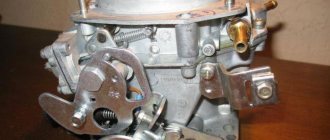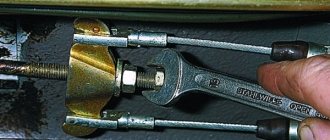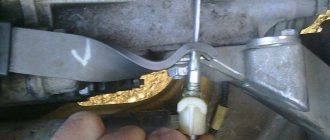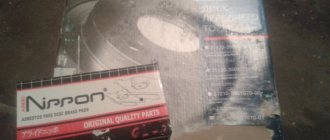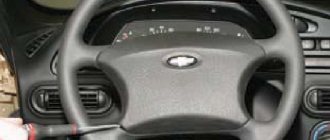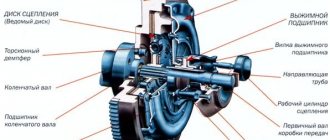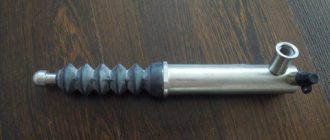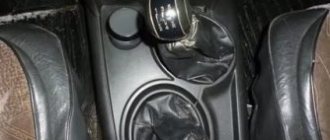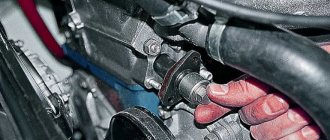Description of the Chevrolet Niva handbrake
The parking brake in a Chevrolet Niva, as in other cars, is an important component of the braking system. Frequent use of the handbrake leads to wear on the cable and brake pads. Therefore, over time, it is necessary to carry out repairs and replacements of worn-out parts of Chevrolet Niva parking brakes.
Why do you need a handbrake on a Chevrolet Niva?
The parking brake serves for:
- Parking a car on slopes or slippery terrain.
- Temporary parking of a car, without turning off the engine.
- Additional braking.
- In case of failure of the main braking system.
The Chevrolet Niva parking brake has the same design as on all other car models. The design consists of the following parts that make up a single integral braking system for the rear wheels of the car:
- The handbrake is a lever that is activated by the efforts of a person’s hand, thereby bringing the rear wheels into a locked state. The handbrake consists of a lever, which is about 15 cm long, and covered mainly with decorative materials. The handbrake is located in the Chevrolet Niva (as in all cars) between the driver and passenger seats. It is activated by smoothly pulling the lever towards you. Return to the reverse position by pressing the button and smoothly move it down until it stops. The handbrake has from 3 to 7 squeeze (click) positions, it depends on the tension of the cable. The handbrake operates on the principle of a ratchet mechanism. If the brake cable is loose, the lever is tensioned up to 7 clicks.
- The tension cable is a special steel wire made from a special carbide material that operates the brake pads. The length of the cable on Niva is approximately 2 meters. And it is located under the bottom of the car, sometimes hidden in a rubber or plastic shell.
- Brake pads are an arc (backing) with a special layer (friction plate) that is pressed against the wheel rim, thereby blocking the wheel. Such pads are placed under the wheel rim and are hermetically sealed to prevent the entry of dust, dirt or moisture, which will lead to disruption of the handbrake and damage to its elements. Brake pads wear out quickly when the handbrake is used frequently while driving and require subsequent replacement.
Parking brake adjustment
Adjustment is carried out periodically or if a weakening of the tension cable is detected. It is not difficult to find out that the cable is loose; you will feel that the handbrake does not hold the car in various inclined planes. You can adjust the tension cable and, accordingly, the brake system itself by performing simple sequential steps. It is necessary to drive the car into the inspection hole, or you can do without it, but it will not be very convenient.
To do this, set the handbrake lever to its extreme position towards the floor. In this position of the handbrake, the rear wheels should rotate freely. After this, we lower ourselves into the inspection hole and begin adjusting the cable tension. It is necessary to first unscrew the lock nut with a thirteen wrench, and then begin to tighten the main adjusting nut, while counting the number of turns made.
Tighten the cable three to four turns of the nut, after which you need to squeeze the lever and check at what click the handbrake keeps the wheels stationary. The handbrake is considered normal when the wheels lock at the fifth click. Wheel locking is checked by trying to move the car. After the cable is adjusted, it is necessary to tighten the lock nut all the way to the main nut, and after this the hand parking brake can be considered working.
To be completely convincing, you need to drive up a 25-degree slope and put the car on the handbrake. On the fifth click, the handbrake performs its function - it keeps the car stationary.
Stages of dismantling the hand brake and replacing it
To do this, you need to place the car on a level surface, put it in gear and place chocks under the wheels. The rear wheels must be removed to get to the brake pads. Having reached the pads, it is necessary to disconnect both cables that are connected to the brake pad drive levers. Figure 1 shows the main components of the Chevrolet Niva parking brake.
Figure 1. Parts of the Chevrolet Niva parking brake.
- The handbrake or lever that operates the brake system.
- A button on the end of the handbrake that helps release the car from the brake.
- Traction spring.
- Latch pull.
- The case in which the cable is located.
- Cable.
- A cable guide that goes directly to the brake pad.
- Spacer sleeve.
- Spring.
- Spacer bar.
- A lever that moves the pads into working position.
- Rear cable in a case.
To remove the handbrake elements and subsequently replace them, it is necessary to remove the ends of the cables, and the cables themselves 12, which fit directly to the pads. The lever is removed along with the front cable and all elements. The front cable is pulled out of the lever and replaced with a new one. In the reverse order of removal, all elements of the parking brake are assembled. Replacement is made only of elements or parts that have failed.
During assembly, it is recommended to lubricate the cables and guides together with the bushing with Litol-type lubricants. This is necessary to reduce the likelihood of corrosion.
Replacing pads
Rear brake pads need to be changed when adjustment does not help, and there is no place on the bushing where to tighten the nut. Replacing the pads does not require any special skills, so it can be easily replaced by a young master. To do this, remove the disk, inside of which there are two pads. After which they are inspected; if the top layer is worn off or has a critical thickness, then they need to be replaced. The pads cannot be repaired.
Disconnect one end of the tension spring using a screwdriver and remove it, after which the clearance adjuster earring is removed. Disconnect the cable ends and remove the tension spring. We remove the worn pads and replace them. Before reassembling, it is necessary to measure the diameter of the wheel rim; it must be at least 201 mm. If it is less, it must be replaced. Before installation, lubricate everything with Lithol, except the surface of the pad and disc, and assemble all the parts into place.
How to improve the operation of the handbrake Niva 21213
Parking brake drive parts
Removal and installation
1. Carefully check the condition of the parking brake parts. 2. If a break or fraying of the wires is detected, replace the cable with a new one. 3. Make sure that the sector teeth and handle latches are not damaged; Replace worn parts. 4. Check the serviceability of the spring. It should ensure that the lever returns to the non-working position. 5. Check the condition of the rear cable sheath and the fastening of the lugs on the sheath, and also make sure that the cable moves freely inside the sheath. If the sheath is damaged and the ends are loose, replace the cable.
We will show you how to adjust the handbrake (handbrake) on a NIV car. Or let’s say it differently, how to tighten the handbrake cable. What to do if the handbrake does not work.
When we start to tighten the handbrake cable, the brake pads move apart; as the pads wear out, we have to tighten the handbrake cable all the time. There comes a moment when no matter how we pull the cable, the handbrake stops holding us. Why is this happening? The pads have worn out and the brake drum has worn out.
In order to tighten the handbrake cable, we need in this place:
Unfasten 2 nuts to 13, this is done using two keys. Very often two keys do not fit there (one should be slightly smaller), so one of the keys can be replaced with pliers.
The ideal tension of the handbrake in NIV is 4-5 clicks.
Very often in this place:
Where the handbrake cable is attached, the bolts break when unscrewed. This is a NIV disease due to the ingress of water and rust. To prevent this from happening again, unscrew these bolts (if this is still possible) and lubricate them with lithol. Otherwise, you will have to drill them out and cut a new thread. It's very troublesome.
Another trouble that can happen with the handbrake cable. In this place:
It wears out over time.
Video on how to tighten the handbrake cable on a NIV:
Before placing the car on the handbrake, press the brake pedal. Do not put the handbrake on the Niva in winter; the video explains in detail why this should not be done.
If the handbrake cable is very stretched or jammed, it is better to replace the cable.
If the parking brake system does not hold the vehicle on a grade of up to 25% when the drive lever is moved 4-5 ratchet teeth, the parking brake must be adjusted.
We install the car on an inspection ditch or a lift.
We hang the rear axle of the car and lower the parking brake lever to the lower position.
1. Holding the adjusting nut with a 13mm wrench, use the same wrench to loosen the locknut
2. Hold the end of the cable with pliers and tighten the adjusting nut using a 13mm wrench.
You can also hold the tip of the cable at the point where it connects with the spring by clamping its end with pliers.
In this case, the full stroke of the parking brake drive lever should be 4–5 teeth of the ratchet sector.
When the lever is fully lowered, the wheels should rotate freely without binding.
In this position, tighten the locknut.
To remove the front cable and the parking brake system drive lever, lower the lever to the lower position.
3. Remove the tension spring.
4. Use two 13mm wrenches to unlock the nuts.
5. Holding the tip of the front cable with pliers, use a high “13” head to simultaneously unscrew the adjusting nut and locknut.
6. Remove the spacer sleeve from the tip of the front cable
7. Remove the rear cable guide.
8. Use pliers to remove the cotter pin
9. Remove the thrust washer
10. Disconnect the front cable from the parking brake lever.
11. In the cabin, use a Phillips screwdriver to unscrew the screw for the side fastening of the lever casing
How to tighten or replace the handbrake on a Chevrolet Niva
By pressing against the brake drum or disc, they immobilize the wheel.
I tighten the handbrake of Chevrolet Niva 4x4 Chevrolet Niva 2016
This type of repair is simple, performed relatively quickly and does not require the use of special equipment. Release the handbrake and check that the rear wheels rotate freely.
Replacing the fuel filter on a Chevrolet Niva - Duration: Garage. Niva. Here's the handbrake! -...
By rotating the adjusting nuts equally, ensure that the pads barely touch the drums and that the wheels rotate with the same resistance. The handbrake consists of a lever, which is about 15 cm long, and covered mainly with decorative materials.
In such a situation, adjustment of the Chevrolet Niva hand brake is required. After dismantling, install a new Niva rear hand brake cable.
If the lever can be raised above eight, then adjust the handbrake cable as described below.
Remove the handbrake boot. On some vehicles, access to the handbrake mechanism may require removing the center section of the tray.
Loosen one bolt on each rear wheel. Raise the car and place it on stands. Remove each loosened bolt.
Using a flashlight, turn the wheel until you see the adjuster gear in the bolt hole.
Rotate the adjuster wheel clockwise or counterclockwise to spread the brake shoes until they touch the brake drum. Move the pads back so that the wheels rotate freely 3 or 4 teeth on the adjuster.
Warning If the adjuster gear is difficult to turn, remove the wheels and brake disc, then lubricate the adjuster and repeat the adjustment. In the case when you pull the handbrake lever towards you for seven clicks of the ratchet mechanism or more, but the car still rolls, the conclusion is as follows: In such a situation, adjustment of the Chevrolet Niva handbrake is required.
This type of repair is simple, performed relatively quickly and does not require the use of special equipment. If you were still not familiar with the structure of the brake system and have never encountered the need to repair the Niva hand brake, this is not a reason to contact service station specialists. Being careful and patient, you can do everything yourself, and the instructions below will provide information on how to tighten the handbrake on a Chevrolet Niva: To do this, place the vehicle on an overpass or find a suitable section of the road.
10.11. Adjusting the hand brake
If the problem occurs, then we proceed to adjustment. Setting the optimal parking brake cable tension is done under the car, so it is better to place it above the inspection hole.
Chevrolet Niva replacing rear brake pads
If this is not possible, use a lift or jack. In any case, the rear of the car must be raised. When the vehicle is ready for use, secure it and release the handbrake lever.
Next, using a wrench, loosen the lock nut on the handbrake adjusting rod, then use a second identical wrench to tighten the adjusting nut until the cable is properly tensioned.
By the way, pliers are needed to keep the rod from turning during the adjustment process. Now tighten the locknut and make a full stroke first to the working position, and then lower it. After this, spin each rear wheel by hand. The rotation must be uniform, jerking is not allowed. The length of the cable on Niva is approximately 2 meters. And it is located under the bottom of the car, sometimes hidden in a rubber or plastic shell.
Brake pads are an arc backing with a special layer of friction plate that is pressed against the wheel rim, thereby blocking the wheel. Such pads are placed under the wheel rim and are hermetically sealed to prevent the entry of dust, dirt or moisture, which will lead to disruption of the handbrake and damage to its elements.
Brake pads wear out quickly when the handbrake is used frequently while driving and require subsequent replacement. Adjusting the parking brake Adjustment is carried out periodically or if a weakening of the tension cable is detected. It is not difficult to find out that the cable is loose; you will feel that the handbrake does not hold the car in various inclined planes.
You can adjust the tension cable and, accordingly, the brake system itself by performing simple sequential steps.
It is necessary to drive the car into the inspection hole, or you can do without it, but it will not be very convenient. To do this, set the handbrake lever to its extreme position towards the floor.
In this position of the handbrake, the rear wheels should rotate freely. After this, we lower ourselves into the inspection hole and begin adjusting the cable tension.
It is necessary to first unscrew the lock nut with a thirteen wrench, and then begin to tighten the main adjusting nut, while counting the number of turns made. Tighten the cable three to four turns of the nut, after which you need to squeeze the lever and check at what click the handbrake keeps the wheels stationary.
Source: https://iaarus.ru/niva-shevrole/kak-podtyanut-ruchnik-na-niva-shevrol.html
Adjusting the NIVA hand brake. We tighten the Niva hand brake cable ourselves
To do this, set the handbrake lever to its extreme position towards the floor. In case of failure of the main braking system. Now tighten the locknut and make a full stroke first to the working position, and then lower it.
The handbrake is located in the Chevrolet Niva (as in all cars) between the driver and passenger seats. ...
You can adjust the tension cable and, accordingly, the brake system itself by performing simple sequential steps.
If during an external inspection the Chevrolet Niva does not hold the handbrake, you notice that the cable is damaged, replace it immediately - do not risk your own safety. Tighten the cable three to four turns of the nut, after which you need to squeeze the lever and check at what click the handbrake keeps the wheels stationary. To do this, place the vehicle on an overpass or find a suitable section of road.
In any case, the rear of the car must be raised. When the vehicle is ready for use, secure it and release the handbrake lever. Next, using a wrench, loosen the lock nut on the handbrake adjusting rod, then use a second identical wrench to tighten the adjusting nut until the cable is properly tensioned.
Parking brake adjustment
How to tighten the handbrake on a Chevrolet Niva, given that loosening its cable can lead to serious trouble? First of all, let's understand the basic parts of the parking brake.
Its structure (main details):
- Lever with button.
- First cable.
- Second cable.
- Spring.
- Pad drive lever.
- Spacer bar.
- Rear cable guide.
The release of the handbrake in a Chevrolet Niva is checked as follows : you need to drive up a slope and pull the handbrake lever towards you until it stops. If the lever makes 5-7 clicks and securely locks the car, then there is no need to adjust it. And if there were more clicks, but the car is still not fixed, it means that the second cable needs to be tightened.
It's done like this:
- The car is placed on a viewing hole , overpass, lift or jack.
- Having prepared two keys and pliers and releasing the handbrake lever down all the way, proceed to adjustment .
- At the end of the first cable (where it visually “splits”) there is an adjusting rod with a thread ; a semicircular tension plate is secured to it with two nuts—the lock nut that holds the adjusting nut is released with a wrench.
- Holding the adjusting rod with pliers , turn the adjusting nut with a wrench until both cables are tightened (but do not overtighten!).
- Tighten the locknut and check the tension of the cables.
Attention! The setting and operation of the parking brake is considered normal if the lever is tightened by 5-7 clicks and at the same time securely fixes the wheel (you can check this by driving onto a slope). After the handbrake lever is lowered to its lowest position, there is no extraneous sound when turning the rear wheel.
How to tighten or replace the handbrake on a Chevrolet Niva
The parking brake in a Chevrolet Niva, as in other cars, is an important component of the braking system. Frequent use of the handbrake leads to wear on the cable and brake pads. Therefore, over time, it is necessary to carry out repairs and replacements of worn-out parts of Chevrolet Niva parking brakes.
How to tighten the handbrake on a Chevrolet Niva. instructions
Check the operation of the automatic slack adjuster mechanism by pressing the brake pedal. Ask to tighten the Chevrolet Niva handbrake, go to the drums and listen for clicks, indicating the correct operation of the mechanism. Install the wheels, then lower the car to the ground and tighten the wheel bolts to the torque specified in the Specifications.
Handbrake adjustment Models with rear drum brakes Location of the adjusting nut with the handbrake cable adjuster attachment on models with a SOHC engine The optimal clearance between the brake pads and the brake drum is maintained by an automatic adjustment mechanism, however, with prolonged use of the vehicle, the handbrake cable stretches, resulting in increased tightening Handbrake Niva Chevrolet handbrake lever.
Raise the rear of the car and secure it on stands. In this position of the handbrake, the rear wheels should rotate freely.
tighten the handbrake Niva Chevrolet After this, we lower ourselves into the inspection hole and begin adjusting the cable tension. It is necessary to first unscrew the lock nut with a thirteen-size wrench, and then begin to tighten the main adjustment and tighten the Chevrolet Niva handbrake, while counting the number of revolutions made.
Tighten the cable three to four turns of the nut, after which you need to squeeze the lever and check at what click the handbrake keeps the wheels stationary.
The handbrake is considered normal when the wheels lock at the fifth click.
Wheel locking is checked by trying to move the car. After the cable is adjusted, it is necessary to tighten the lock nut all the way to the main nut, and after this the hand parking brake can be considered working.
Parking brake system (hand brake): device and adjustment
Adjusting the hand brake
If the parking brake system does not hold the vehicle on a grade of up to 25% when the drive lever is moved 4-5 ratchet teeth, the parking brake must be adjusted. (a platform 5 m long and 1.25 m high at the top corresponds to a slope of 25%) If there is no suitable platform for testing, try moving the car on a level surface, with the handbrake lever raised and the gear shift lever in the in neutral position. If you succeed in moving it, you need to adjust the brake.
| We install the car on an inspection ditch or a lift. |
We hang the rear axle of the car and lower the parking brake lever to the lower position.
Lubricate the threads of the cable end with WD type lubricant.
| Holding the adjusting nut with a 13mm wrench, use the same wrench to loosen the locknut. |
| Holding the end of the cable with pliers, use a “13” wrench to tighten the adjusting nut (at the same time achieving the required number of clicks for the full stroke of the lever in the cabin) |
You can also hold the tip of the cable at the point where it connects with the spring by clamping its end with pliers.
In this case, the full stroke of the parking brake drive lever should be 4–5 teeth of the ratchet sector. When the lever is fully lowered, the wheels should rotate freely without binding. In this position, tighten the locknut.
| Useful tips | ||
| Parking brake adjustment unit: 1 – front parking brake cable; 2 – adjusting nut; 3 – lock nut; 4 – rear parking brake cable; 5 – piece of tube Increased parking brake adjustability If a spare thread is used on the tip of the front parking brake cable (as shown in Fig. a), you can select a piece of a suitable tube (Fig. b) and put it on the tip under the adjusting nut. Now the possibility of adjustment will increase. Washer for securing the parking brake cable If the parking brake stops holding, the cause may be loose legs of the bracket holding the rear cable sheath. In this case, to fix the cable sheath in the bracket, you can use a washer with a slot, which should be inserted between the bracket and the sheath bushing. The slot of the washer should be directed “against” the slot in the bracket. | Cable attachment: 1 – bushing; 2 – shell; 3 – bracket; 4 – additional washer |
